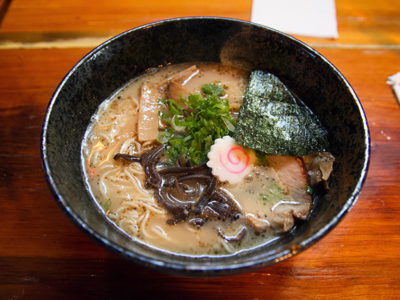The future of Kotatsu
Kotatsu is only beginning to take foot in Cardiff. Organiser Eiko mentioned they were hoping to “have a Welsh premiere of an animation film every year, because people can’t always go to bigger cities to watch a film, so we’re trying to bring them here.” “Last year was our first year, so we’re starting to gather momentum now, we hope it will continue. And not just for one or two days, but you’ll see elements of Kotatsu scattered through Chapter’s programme; it will be like the festival is running for the whole year,” added Matt Beere.
Glorious food in Ghibli films:
[youtube width=”236″ height=”200″]http://www.youtube.com/watch?v=ctCa6KkjimU[/youtube]
How anime and manga have propelled sushi from high-class cuisine to popular food for everyone

one of the bento-boxes sold at the Kotatsu Animation Festival, including crispy chicken, pickled raddish, mashed potato and veg, quiche and spring rolls (photo by: GD)
One of Britain’s most popular trendy foods is sushi. But while some still think it’s fairly new, sushi has actually been around for some time. In fact by now it has been fully integrated into British culture and you can find it anywhere from Marks&Spencer to Tesco.
After sushi, Korean food – particularly Korean barbeque – is now the newest trend. Korean restaurants, which often sell Japanese dishes as well, can be found in many places in London and now also Cardiff.
The Kotatsu Animation Festival at Chapter Arts Centre in November was an occasion to celebrate Japanese and Korean culture and food through the medium of animation films. In addition to film-showings at the cinema, there were Japanese calligraphy workshops as well as some stalls selling comic books and merchandise in the main hall. Lunch in the form of so-called bento boxes was provided by Yakiniku, a Japanese and Korean restaurant on Newport Road. The festival was a brilliant opportunity to have a snoop around and ask people why and how Asian food has become so popular.
Food and anime films
“I know a few people that have gotten into manga and then became much more involved in Asian culture,” said Bekah Kay, one of the visitors at Kotatsu. Manga – Japanese comic books – and anime – Japanese cartoons – were among the first outbursts of Japanese pop-culture in Britain. Who doesn’t remember watching Dragonball, Sailor Moon, or (for the older generation) Thundercats and Inspector Gadget?
“I think anime and manga have introduced into Western culture an element of Eastern tradition and with that comes food, as it’s part of the culture,” said Matt Beere, film education officer at Chapter. Indeed, while mainly celebrating Japanese animation, the festival’s name itself is food-related: “Kotatsu” is the Japanese word for a square table fitted with a blanket, where the Japanese family eats together.
Eiko Ishii Meredith, organiser of Kotatsu, gave her opinion on why Japanese food is so popular: “It’s so unusual and unique, so different from Western culture, so maybe that’s why people like it. They can compare it to their own culture.”
Asked what she liked most about Japanese food, she replied, “We have food that looks very delicate, such as the display of Japanese food and sweets – they’re so nice and beautiful.” Festivalgoers agreed with this, “It’s not just eating, it’s an experience,” added Jade Price.
One series of anime films that particularly feature Asian food are the Studio Ghibli productions. Among them is Spirited Away, the first anime to win an Oscar and the start of the Ghibli phenomenon in Europe and the US. The film shows a variety of traditional Japanese dishes, and the repercussions of bad table manners – like Chihiro’s parents who are turned into pigs for eating food meant for the gods, which is why Chihiro gets spirited away. But it’s not the only example: Howl’s Moving Castle features a mouth-watering scene about making breakfast, Ponyo teaches viewers how to make a Japanese noodle soup called ramen, and My Neighbour Totoro shows a girl preparing bento boxes for her family. No matter which Ghibli film, they all share a special relationship with food, focusing on the glossy or soft textures of the steaming dishes and the smiling faces of the characters that enjoy them.
Asian restaurants in Cardiff
Anime and manga have helped to influence Britain’s food culture: Packs of instant noodles fill the shelves of every supermarket. Yo!Sushi and Wasabi chain restaurants can be found in almost every major city in the UK, including Cardiff. And for those who are brave enough to try making their own sushi, there are specialist shops selling produce and ingredients imported straight from Japan.
“As far as I know, there are some Japanese cooking lessons operated by Sushi Day, so local people interested in Japanese or Korean food attend these lessons, and then come back to the shop and buy the stuff to make the dishes themselves. They always ask a lot of questions about Asian food, which we’re happy to answer,” said Xiaodan Yuan, who works at CKJ Foods, a Korean and Japanese food shop in Woodville Road.
“Six years ago, when we first started this business, the customers were 90% Japanese people, but now we get more and more local people,” said Sumi Ko, owner of Yakiniku. In comparison to older Asian restaurants that had to adapt their dishes more to European tastes, the new wave of Japanese and Korean restaurants often serve original and genuine Japanese and Korean recipes.
There are also hybrid-restaurants mixing Eastern and Western traditions like Wagamama, but if you want to enjoy an authentic Japanese meal with miso soup, tempura and green tea, there are several places to choose from in Cardiff.
So with the DVD release of the newest Ghibli film Arrietty coming up in January, maybe you can make a day of it and add to the authentic experience by eating out at one of Cardiff’s Japanese or Korean restaurants after watching the film – or head to the Asian shop to buy the ingredients and make sushi yourself.
The future of Kotatsu
Kotatsu is only beginning to take foot in Cardiff. Organiser Eiko mentioned they were hoping to “have a Welsh premiere of an animation film every year, because people can’t always go to bigger cities to watch a film, so we’re trying to bring them here.” “Last year was our first year, so we’re starting to gather momentum now, we hope it will continue. And not just for one or two days, but you’ll see elements of Kotatsu scattered through Chapter’s programme; it will be like the festival is running for the whole year,” added Matt Beere.
Glorious food in Ghibli films:
[youtube width=”236″ height=”200″]http://www.youtube.com/watch?v=ctCa6KkjimU[/youtube]










